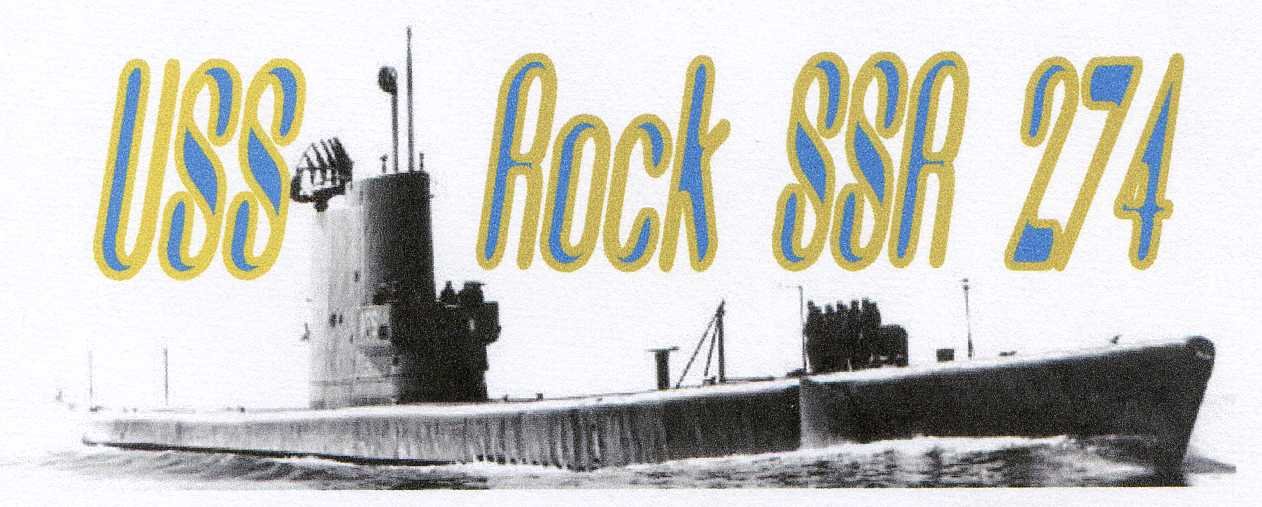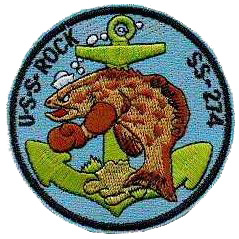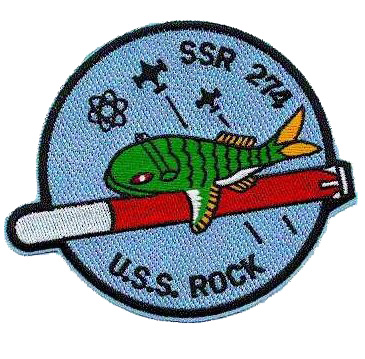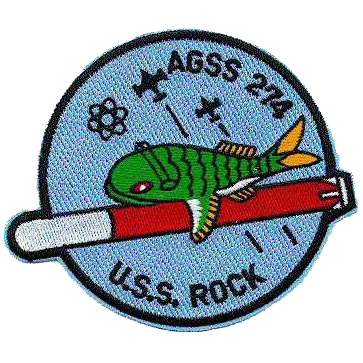

|
| |
|||||
|



|
||||
|
Specifications: Displacement, Surfaced: 1,526 t., Submerged: 2,424 t.; Length 311' 9"; Beam 27' 3"; Draft 15' 3"; Speed, Surfaced 20.25 kts, Submerged 8.75 kts; Complement 6 Officers 54 Enlisted; Operating Depth, 300 ft; Submerged Endurance, 48 hrs at 2 kts; Patrol Endurance 75 days; Cruising Range, 11,000 miles surfaced at 10 kts; Armament, ten 21" torpedo tubes, six forward, four aft, 24 torpedoes, one 3"/50 deck gun, two .50 cal. machine guns, two .30 cal. machine guns; Propulsion, diesel electric reduction gear with four General Motors main generator engines, HP 5400, Fuel Capacity, 116,000 gals., four General Electric main motors, HP 2740, two 126-cell main storage batteries, twin propellers.
USS Rock (SS/SSR/AGSS-274), a Gato-class submarine, was a ship of the United States Navy to be named for the rock, a striped bass found in the Chesapeake Bay region and elsewhere along the Atlantic Coast.
Rock (SS-274) was laid down by the Manitowoc Shipbuilding Co., Manitowoc, Wisc., December 1942; launched 20 June 1943; sponsored by Mrs. B. O. Wells, and commissioned 26 October 1943, Comdr. John Jay Flachsenhar in command.
After a month of intensive training in Lake Michigan, Rock passed through the Chicago Sanitary and Ship Canal (at the time known as the Chicago Drainage Canal) to Lockport,
First and second war patrols, February - May 1944
On 29 February 1944, Rock contacted a large enemy convoy en route to Truk. Detected by destroyer Asashimo while making a night surface approach on the convoy, she fired a spread of four torpedoes from her stern tubes at the closing enemy destroyer without scoring. Then illuminated by the destroyer's searchlight, and under fire from the surface ship's 5-inch (130 mm) guns, she dived. For 4 hours she underwent depth charge attacks, but survived. That night she surfaced and found that her periscopes were excessively damaged and that her bridge had been riddled with shrapnel. The damage necessitated a return to Pearl Harbor for repairs. Later that night, the busy Asashimo sank Trout.
Rock began her second war patrol on 4 April 1944, destination Honshū. However, after 34 days in the Bungo Suido and Sagami Wan area without action, she returned to Majuro where she was refitted by Sperry (AS-12).
Third war patrol, June - August 1944
Rock, in company with Tilefish and Sawfish, departed Majuro on 22 June 1944, in a coordinated attack group to patrol the Luzon Strait. At dawn on 19 July Rock attacked a Japanese convoy of seven large ships and three escorts, firing 10 torpedoes, six of which exploded. But, as she immediately dove to escape a depth-charge attack, she could not observe their effect.
Two days later Rock contacted another enemy convoy consisting of six large ships and four escorts. She launched four torpedoes, two of which seemed to hit but, again Rock was forced down by depth charges and unable to assess damage to her targets. During the remainder of her time on station, Rock weathered a severe typhoon and witnessed the sinking of Japanese submarine I-29 by Sawfish. On 27 July she headed toward Pearl Harbor.
Fourth war patrol, September - November 1944
Rock departed Pearl Harbor on 9 September 1944, en route for the South China Sea for her fourth patrol. On 26 October 1944, she scored three hits on a tanker, Rock's only sinking, Takasago Maru No. 7, accompanied by three escorts. On 27 October 1944, she fired nine torpedoes at Darter, stranded on Bombay Shoal, to prevent her salvage by the Japanese. Three of the torpedoes were hits. This patrol ended when Rock departed the area and sailed for Fremantle,
Fifth and sixth war patrols, December 1944 - May 1945
On 14 December 1944, Rock departed Fremantle on her fifth patrol. The only event of note during this 64-day patrol was the rescuing of a downed pilot from Lexington (CV-16).
At the start of her sixth patrol, 7 March to 4 May 1945 she picked up 15 merchant seamen, adrift in a life raft for 32 days, and landed them at Exmouth. Continuing northward the next day, Rock was bombed by an aircraft and that night she was struck by a dud torpedo. Neither attack caused any critical damage. In a night attack on 27 March, Rock fired on an enemy destroyer escort without success. On 18 April she joined Tigrone in bombarding Batan Island to leave the Japanese radio station in ruins. Rock then turned toward Saipan to complete a 54-day patrol.
From the Marianas the submarine headed for the United States, arriving at Hunter's Point, San Francisco, 14 May for overhaul. She sailed for Pearl Harbor 7 August 1945, but with the cessation of hostilities was ordered east.
Officially credited with damaging 42,282 tons of enemy shipping during her six war patrols, Rock participated in Navy Day celebrations at New Orleans, then proceeded to New London where she began inactivation in November 1945. She was decommissioned 1 May 1946 and was berthed as a unit of the Atlantic Reserve Fleet.
Radar picket submarine (SSR-274), 1953-1959
In early 1951 Rock was towed from New London to the Philadelphia Naval Shipyard, where she was converted to a radar picket submarine by bisecting her at the forward bulkhead of the control room and inserting a 30-foot (9 m) section between the control room and the forward battery to house the new CIC and the majority of her new electronic equipment. Reclassified SSR-274 on 18 July 1952, Rock recommissioned at Philadelphia 12 October 1953.
After a short period of training with SubRon 6 off the Virginia Capes, she proceeded to San Diego to join SubRon 5. On 23 July 1954, she departed San Diego for the western Pacific area and a 6-month tour on the Taiwan Strait Patrol. She subsequently alternated deployments to WestPac with operations off the Pacific coast. She made 6-month deployments to WestPac in 1956 and during the winter of 1958-1959.
Auxiliary general submarine (AGSS-274), 1959-1969
On 31 December 1959 there no longer existed an operational requirement for a radar picket submarine in the Fleet, and on that date the Air Control Center was decommissioned and Rock was redesignated "auxiliary general submarine" AGSS-274. Following operations off the Pacific coast and another overhaul, Rock again deployed to WestPac in November 1961. She made subsequent 6-month deployments to WestPac in 1963, 1965, 1966-1967, and 1968.
Operating in the eastern Pacific during the first half of 1969, Rock departed San Diego 11 July and conducted operations in support of fleet training in the Hawaiian operating areas until steaming 16 August for the Pacific coast. Less than a month later, on 13 September 1969, Rock decommissioned at Puget Sound Naval Shipyard. Struck from the Navy List on the same day, she was designated for use as a target to destruction.
Rock earned four battle stars for World War II service.
|
|
Webmaster: Scott@RockSSR274.com to send pictures, offer suggestions or give constructive criticism.
This material may not be published, broadcast, rewritten or redistributed in any form without permission from RockSSR274.com.
|